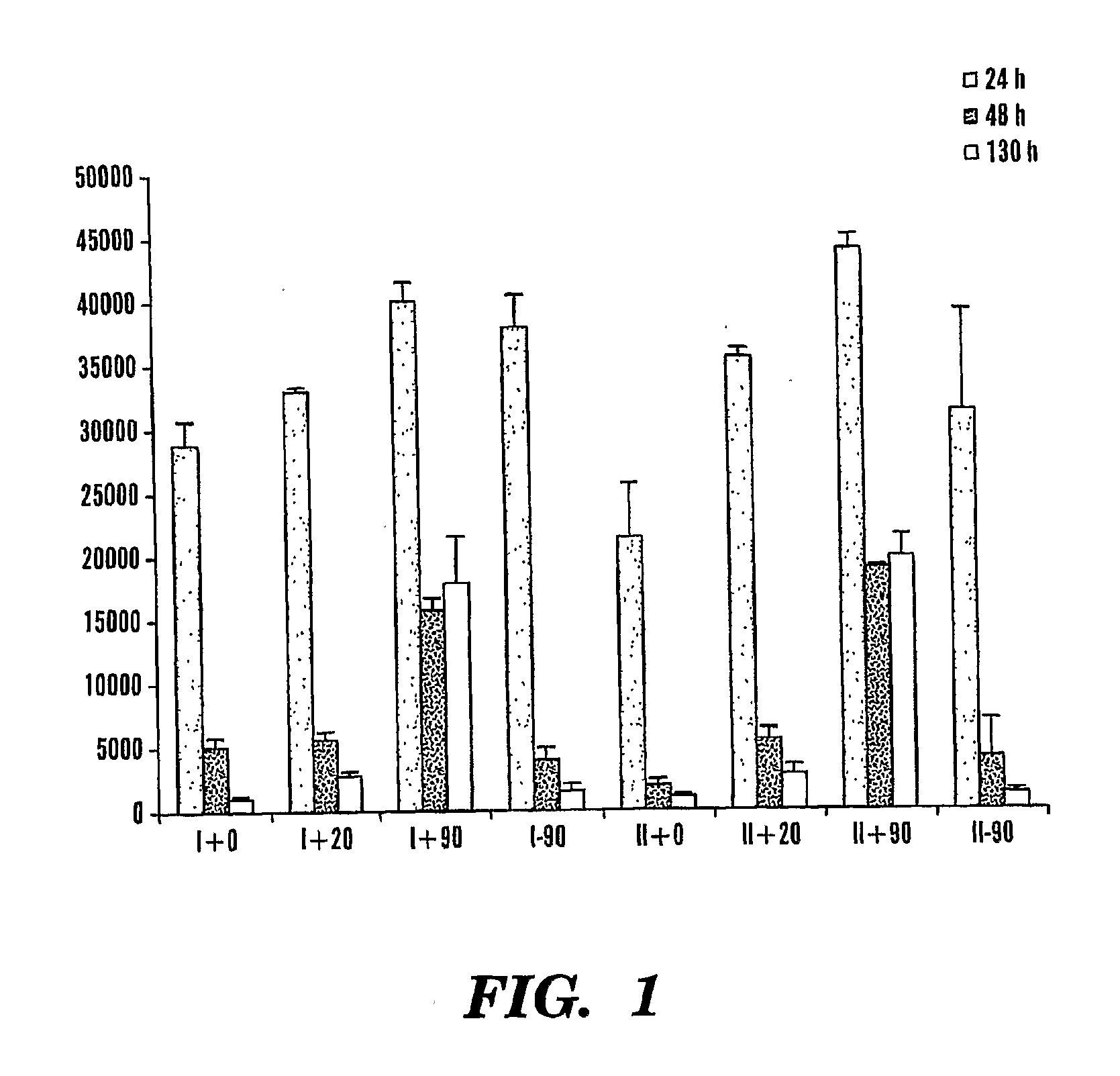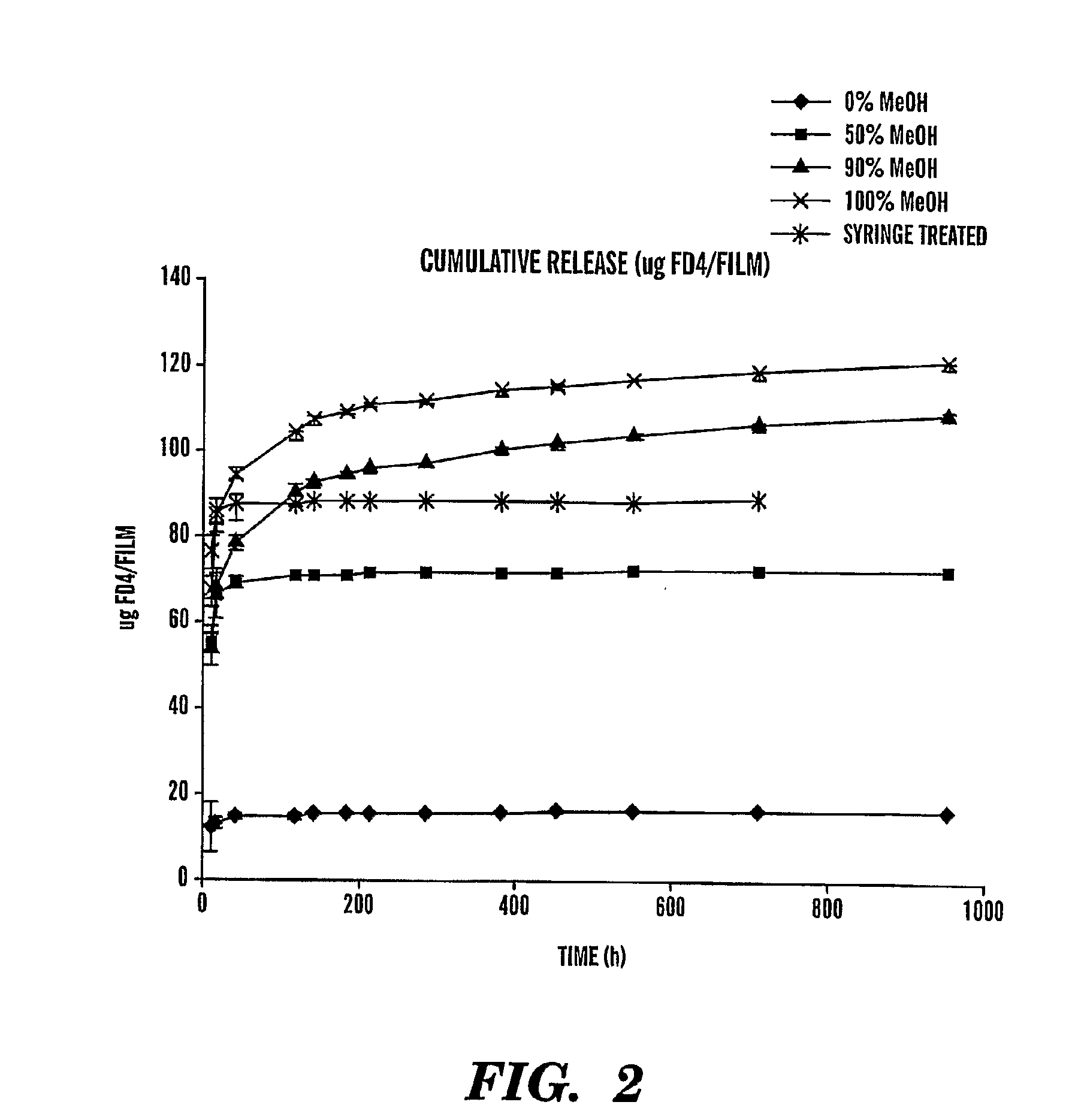Silk-Based Drug Delivery System
- Summary
- Abstract
- Description
- Claims
- Application Information
AI Technical Summary
Benefits of technology
Problems solved by technology
Method used
Image
Examples
example i
Materials and Methods: Preparation of Silk
[0073]Silk cocoons were cut in quarters and washed in Na2CO3 solution for 1 hour. The silk was washed 2 times with hot water and 20 times with cold water. Silk was dried over night and dissolved in 9M LiBr to become a 10% silk-fibroin solution. The solution was centrifuged at 27,000 g for 30 minutes and the supernatant was transferred in a dialysis cassette (MWCO 3,500) and dialyzed for 2 days. Silk-fibroin concentration was adjusted to 5% (m / V in water) by evaporation at 250 mbar and 45° C. The resulting silk solution was either mixed with a solution of FITC coupled to dextran (molecular weight of 4 kDa; FD4; concentration 10 mg / ml, Sigma) in a ratio of 150 ul silk-fibroin solution to 20 ul of FD4 solution, or the FD-4 was added later for control groups (see table 1). As a further group, parts of this solution were sonicated with 50 Hz, 2A, 10 sec (Hielscher, UP200H). 170 ul of the solution (FD-4 / silk mixture) was added into each well of a ...
example 2
[0076]We evaluated the feasibility to formulate drug delivery systems based on silk-fibroin. The experiments started from an aqueous fibroin-drug solution, followed by a slow evaporation of the water resulting in a solid fibroin film with suspended drug molecules. A conformational change of the fibroin was induced through methanol treatment, resulting in an increase of crystallinity. The degree of crystallinity governed the release of the drug.
Results & Discussion
[0077]Dextrans coupled to a fluorescent dye were chosen as a model drug. They allow a straightforward assessment of the influence of drug molecular weight on swelling gels. FD4—a term used in this summary describes FITC (F) coupled to a dextran (D) with a molecular weight of 4,000 g / mol. A first set of experiments compared FD4 release from fibroin gels treated with water and ascending methanol concentrations (FIG. 2).
[0078]FIG. 2 shows the release of FD4 over time. The differences in maximum FD4 concentrations stems from di...
example 3
[0083]The exposure of silk films to methanol suggested an increase in crystallinity, as determined by FTIR analysis (FIG. 7A). This finding was based on a Amide II bond shift from 1540 cm−1 to 1535 cm−1, a finding typical for the increase in β-crystalline structures. Similarly, an additional shoulder appeared in response to methanol treatment at 1630 cm−1 (Amide I) and 1265 cm−1 (Amide III).
[0084]This data was corroborated by X-ray diffractometry (FIGS. 7B and 7C). The hydrophobicity of the film surfaces were significantly influenced by the crystallinity change of the films in response to methanol treatment, as determined by contact angle measurements (FIGS. 7D and 7E). For methanol treated films no change of the contact angle was observed over time, indicating the water-insolubility of these films as opposed to water treated films, in which a rapid decrease in contact angles resulted after 3 minutes of exposure to a water droplet.
[0085]The topology of silk films before and after me...
PUM
| Property | Measurement | Unit |
|---|---|---|
| Fraction | aaaaa | aaaaa |
| Fraction | aaaaa | aaaaa |
| Fraction | aaaaa | aaaaa |
Abstract
Description
Claims
Application Information
 Login to View More
Login to View More - R&D
- Intellectual Property
- Life Sciences
- Materials
- Tech Scout
- Unparalleled Data Quality
- Higher Quality Content
- 60% Fewer Hallucinations
Browse by: Latest US Patents, China's latest patents, Technical Efficacy Thesaurus, Application Domain, Technology Topic, Popular Technical Reports.
© 2025 PatSnap. All rights reserved.Legal|Privacy policy|Modern Slavery Act Transparency Statement|Sitemap|About US| Contact US: help@patsnap.com



